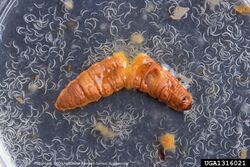Chemistry:Tapinarof
 | |
| Clinical data | |
|---|---|
| Trade names | Vtama |
| Other names | Benvitimod; GSK-2894512; (E)-3,5-Dihydroxy-4-isopropyl-trans-stilbene; 3,5-Dihydroxy-4-isopropylstilbene |
| License data | |
| Routes of administration | Topical |
| ATC code | |
| Legal status | |
| Legal status | |
| Identifiers | |
| |
| CAS Number | |
| PubChem CID | |
| DrugBank | |
| ChemSpider | |
| UNII | |
| KEGG | |
| ChEMBL | |
| Chemical and physical data | |
| Formula | C17H18O2 |
| Molar mass | 254.329 g·mol−1 |
| 3D model (JSmol) | |
| |
| |
Tapinarof, also known as benvitimod and sold under the brand name Vtama, is a medication used for the treatment of plaque psoriasis.[1] The medication is applied to the skin.[1] Besides its use in medicine, tapinarof is a naturally occurring compound found in bacterial symbionts of nematodes which has antibiotic properties.[2][3]
The medication acts as an aryl hydrocarbon receptor agonist.[1][4]
Tapinarof was approved for medical use in the United States in May 2022.[1][5][6][7] The US Food and Drug Administration (FDA) considers it to be a first-in-class medication.[8][9]
Medical uses
Tapinarof is indicated for the treatment of plaque psoriasis in adults.[1]
Side effects
In case of short term use the most common adverse effects are folliculitis, contact dermatitis, headache, pruritus, and upper respiratory tract infection.[10][11]
Pharmacology
Mechanism of action
Tapinarof binds directly to topical aryl hydrocarbon receptor (AhR), suppressing inflammatory cytokines, modulating skin barrier protein expression, reducing oxidative stress, and regulating gene expression in immune cells.[12][13][14]
Efficacy
Tapinarof 1% cream once daily was superior to vehicle control in reducing the severity of plaque psoriasis over a period of 12 weeks and having a favorable safety profile in the treatment of psoriatic patients.[10][15]
History
Tapinarof, also known as benvitimod and sold under the brand name Vtama, is a medication used for the treatment of plaque psoriasis.[1] The medication is applied to the skin.[1] Besides its use in medicine, tapinarof is a naturally occurring compound found in bacterial symbionts of nematodes which has antibiotic properties.[2][3]
The medication acts as an aryl hydrocarbon receptor agonist.[1][4] Tapinarof was approved for medical use in the United States in May 2022.[1][5][6][7] The US Food and Drug Administration (FDA) considers it to be a first-in-class medication.[8]
Society and culture
Names
Tapinarof is the international nonproprietary name.[16]
Natural occurrence

Tapinarof, also known as benvitimod, is a bacterial stilbenoid produced in Photorhabdus bacterial symbionts of Heterorhabditis nematodes. It is a product of an alternative ketosynthase-directed stilbenoid biosynthesis pathway. It is derived from the condensation of two β-ketoacyl thioesters.[2] It is produced by the Photorhabdus luminescens bacterial symbiont species of the entomopathogenic nematode, Heterorhabditis megidis. Experiments with infected larvae of Galleria mellonella, the wax moth, support the hypothesis that the compound has antibiotic properties that help minimize competition from other microorganisms and prevents the putrefaction of the nematode-infected insect cadaver.[3]
References
- ↑ 1.0 1.1 1.2 1.3 1.4 1.5 1.6 1.7 1.8 1.9 "Vtama- tapinarof cream". 23 May 2022. https://dailymed.nlm.nih.gov/dailymed/drugInfo.cfm?setid=9309d20f-8cd4-4c96-93fa-7f730e83c7ab.
- ↑ 2.0 2.1 2.2 "Bacterial biosynthesis of a multipotent stilbene". Angewandte Chemie 47 (10): 1942–1945. 2008. doi:10.1002/anie.200705148. PMID 18236486.
- ↑ 3.0 3.1 3.2 "Antibiotic production in relation to bacterial growth and nematode development in Photorhabdus--Heterorhabditis infected Galleria mellonella larvae". FEMS Microbiology Letters 189 (2): 219–223. August 2000. doi:10.1111/j.1574-6968.2000.tb09234.x. PMID 10930742.
- ↑ 4.0 4.1 "Tapinarof in the treatment of psoriasis: A review of the unique mechanism of action of a novel therapeutic aryl hydrocarbon receptor-modulating agent". Journal of the American Academy of Dermatology 84 (4): 1059–1067. April 2021. doi:10.1016/j.jaad.2020.10.085. PMID 33157177.
- ↑ 5.0 5.1 "Vtama: FDA-Approved Drugs". https://www.accessdata.fda.gov/scripts/cder/daf/index.cfm?event=overview.process&ApplNo=215272.
- ↑ 6.0 6.1 "Vtama (Tapinarof) FDA Approval History". https://www.drugs.com/history/vtama.html.
- ↑ 7.0 7.1 "FDA Approves Dermavant's Vtama (tapinarof) cream, 1% for the Treatment of Plaque Psoriasis in Adults: First Topical Novel Chemical Entity Launched for Psoriasis in the U.S. in 25 Years". Dermavant Sciences (Press release). 24 May 2022. Archived from the original on 24 May 2022. Retrieved 24 May 2022.
- ↑ 8.0 8.1 "Advancing Health Through Innovation: New Drug Therapy Approvals 2022". 10 January 2023. https://www.fda.gov/drugs/new-drugs-fda-cders-new-molecular-entities-and-new-therapeutic-biological-products/new-drug-therapy-approvals-2022.
 This article incorporates text from this source, which is in the public domain.
This article incorporates text from this source, which is in the public domain.
- ↑ (PDF) New Drug Therapy Approvals 2022 (Report). January 2024. https://www.fda.gov/media/164429/download. Retrieved 14 January 2024.
 This article incorporates text from this source, which is in the public domain.
This article incorporates text from this source, which is in the public domain.
- ↑ 10.0 10.1 "Tapinarof for the treatment of psoriasis". Dermatologic Therapy 35 (12): e15931. December 2022. doi:10.1111/dth.15931. PMID 36226669.
- ↑ "Phase 3 Trials of Tapinarof Cream for Plaque Psoriasis". The New England Journal of Medicine 385 (24): 2219–2229. December 2021. doi:10.1056/NEJMoa2103629. PMID 34879448.
- ↑ "Tapinarof in the treatment of psoriasis: A review of the unique mechanism of action of a novel therapeutic aryl hydrocarbon receptor-modulating agent". Journal of the American Academy of Dermatology 84 (4): 1059–1067. April 2021. doi:10.1016/j.jaad.2020.10.085. PMID 33157177.
- ↑ "Aryl Hydrocarbon Receptor in Atopic Dermatitis and Psoriasis". International Journal of Molecular Sciences 20 (21): 5424. October 2019. doi:10.3390/ijms20215424. PMID 31683543.
- ↑ "Systemic Pharmacokinetics, Safety, and Preliminary Efficacy of Topical AhR Agonist Tapinarof: Results of a Phase 1 Study". Clinical Pharmacology in Drug Development 7 (5): 524–531. June 2018. doi:10.1002/cpdd.439. PMID 29389078.
- ↑ "Phase 3 Trials of Tapinarof Cream for Plaque Psoriasis". The New England Journal of Medicine 385 (24): 2219–2229. December 2021. doi:10.1056/NEJMoa2103629. PMID 34879448.
- ↑ "International nonproprietary names for pharmaceutical substances (INN): recommended INN: list 78". WHO Drug Information 31 (3). 2017.
 |

